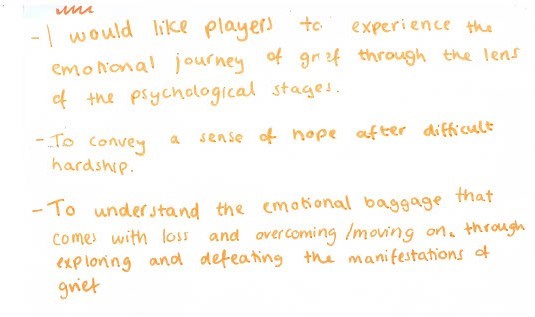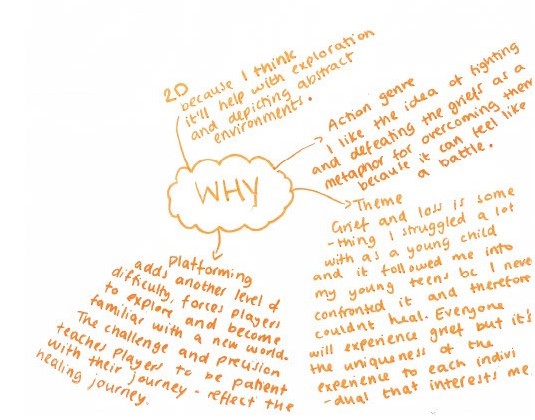The Essential Experience
After successfully defining and understanding the Essential Experience over the last couple weeks, avoiding all digital materials we were prompted to create mindmaps, brainstorm and come up with some loglines that related to our games essential experience. To be able to write it out clearly is a significant foundation for any project, having it set out will ensure that it feeds the design intention all the way through from start to finish.
What we were really asking ourselves today was: what do I want the player to feel and experience as they play this game? Which isn’t the easiest thing to articulate despite how simple of a question it sounds.

I came up with 3 loglines. I knew what I wanted to say but it was hard to make it succinct. In the end, I came up with one that I felt was solid and wrapped everything up in one (scroll to the pink post-it-note below). Another important question to ask was “why?”, why was I making certain decisions about my game and do they make sense?

While everything is subject to change because it is so early on in development, it’s good practice to make sure everything is questioned and has an outlined reason why, that way I always have something to go back to and it’ll make me feel more secure in my work. I considered the genre, style and theme. While not every game has to be personal, I believe that relating it to my own experience will help me not only convey the essential experience to the audience more accurately, but it’ll also make me feel more connected to my work and therefore put that little extra bit of care into it.
Then it was time to think about play structures and where my game would belong considering the essential experience I had chosen. Of course the next logical step was to look into The Kübler-Ross model of grief, also known as The Five Stages of Grief, a framework that describes the emotions people experience after a sudden loss.

Concept Art
Thursday we are introduced to concept art, and how art is much more than just technical ability. Think about:
- The skill to be fluent in a precise vocabulary and have a wide knowledge of different visual styles as well as their affective power
- The knowledge of textures, colours, shapes – these all have meaning
- Considering art that has a unique look & feel rather than art that can be considered an “impressive clone”
Reference materials will help develop ideas and mood boards, as well as improve anatomy, perspective, lighting, and composition skills. They can also be used to solve design problems and find creative solutions or perhaps most relevant to the GDD – communicate your vision to the team. Upon hearing this, I did what any artist would do. Go to Pinterest. I searched high and low to create moodboards and find inspiration from existing concept designs. Having examples and references is a game changer for me, letting me solidify my ideas and keep everything organised and explained.
Important questions and considerations:
- Art Period: Use a few words to describe the overall artistic style of the world.
- Reference Materials:
- What is the reference for?
- Include the credit for the reference images
- Try to include reference of photos, as opposed to other artists work, since using original source references helps avoid just reinterpreting exactly what has been done before.
Leave a Reply